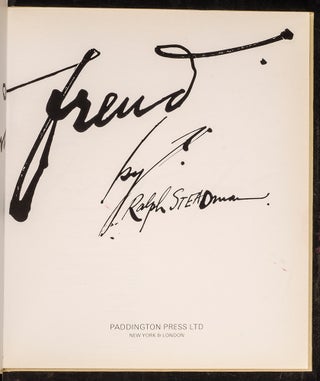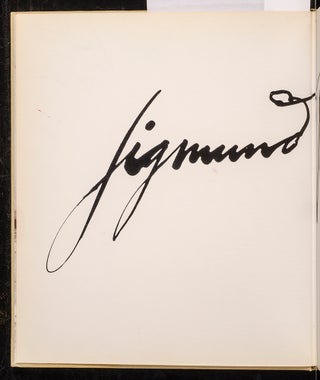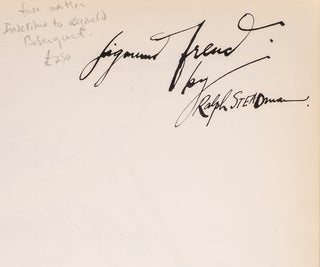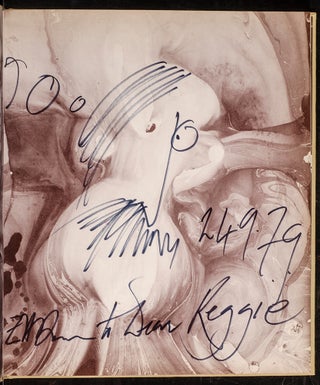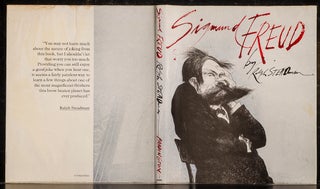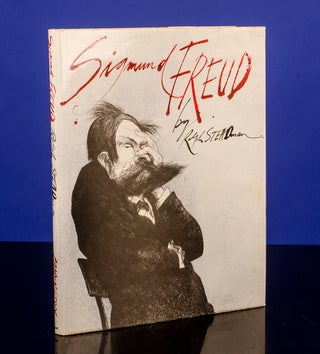Sigmund Freud by Ralph Steadman
New York: Paddington Press, 1979. Item #04476
"Oedipus"
STEADMAN, Ralph, Illustrator. Sigmund Freud by Ralph Steadman. New York: Paddington Press Ltd., 1979.
First edition, first printing. Inscribed across the front endpapers by the illustrator to journalist and broadcaster Reginald Bosanquet (1932 - 1984), "Mother love from Ralph Steadman to Dear Reggie 24.9.79". With an original drawing of a thought bubble from Sigmund Freud saying, "Too much sex - not enough mother love - that's his problem! Send him to me!".
Quarto (12 x 10 5/16 inches; 306 x 262 mm.). 117, [1], [2, blank] pp. Profusely illustrated throughout including several full page and double-page drawings.
Publisher's light gray textured paper over boards, spine lettered in dark red. Minimal toning to board edges. Publisher's pictorial dust jacket minimal toning to edges, short closed tear to head of front flap joint, small water stain and minor rippling to head of rear panel and rear flap, otherwise fine.
"The culmination of more than three years' research and sustained creative effort, Steadman's FREUD is superbly illustrated and designed with more than 50 major drawings and 25 vignettes, representing the most powerful and emotive collection of work that Steadman has yet produced. Charged with humor, pathos, penetrating insight and brilliant draftsmanship on every page, it is destined to be hailed as one of the most cleverly orchestrated and profoundly original illustrated books of our times." (rear flap).
Ralph Steadman and Reginald Bosanquet had met each other in the sixties at many social gatherings at Turret Books in Kensington Church Walk, London. Bernard Stone (1925-2005), the owner of Turret Books published lavish limited editions of poetry, art and music. All were printed on hand-made paper and signed by the writers, etc. He also sold books, mainly second-hand and put on readings in the shop as well. "The shop ran like a club! You walk in (and this went for anyone!), and within 5 minutes you had a glass of wine (which became several within half an hour) and Bernard was enthusing madly about someone or something he wanted to put on the map. He was brilliant!! Regular liggers in the shop were Reginald Bosanquet ITN newscaster), Ralph Steadman (illustrator), Frank Dickens (1931-2016, cartoonist - Bristow, etc) and Adrian Henri (1932-2000) the British poet and painter best remembered as the founder of poetry-rock group The Liverpool Scene." (www.andyrobertsmusic.com). Ligger. An individual who attends parties, openings, social gatherings and events with the sole intention of obtaining free food and drink - an arch blagger. (Urban Dictionary).
Ralph Steadman (born 15 May 1936) is a Welsh illustrator best known for collaboration with the American writer Hunter S. Thompson, his close friend. Steadman attended East Ham Technical College and the London College of Printing during the 1960s, doing freelance work for Punch, Private Eye, the Daily Telegraph, The New York Times and Rolling Stone during this time. He is a patron of the Association of Illustrators. Steadman is renowned for his political and social caricatures, cartoons and picture books. Awards that he has won for his work include the Francis Williams Book Illustration Award for Alice in Wonderland, the American Society of Illustrators' Certificate of Merit, the W H Smith Illustration Award for I Leonardo, the Dutch Silver Paintbrush Award for Inspector Mouse, the Italian Critica in Erba Prize for That's My Dad, the BBC Design Award for postage stamps, the Black Humour Award in France, and several Designers and Art Directors Association Awards. He was voted Illustrator of the Year by the American Institute of Graphic Arts in 1979. Steadman had a long partnership with the American journalist Hunter S. Thompson, drawing pictures for several of his articles and books. He accompanied Thompson to the Kentucky Derby for an article for the magazine Scanlan's, to the Honolulu Marathon for the magazine Running, and illustrated both Fear and Loathing in Las Vegas and Fear and Loathing on the Campaign Trail '72. Steadman has expressed regret at selling the original illustrations for Fear and Loathing in Las Vegas at the advice of his agent to Rolling Stone founder Jann Wenner for the sum of $75, a fraction of their significant value. As a result of that transaction Steadman has largely refused to sell any of his original artwork and has been quoted as saying "If anyone owns a Steadman original, it's stolen." While there are original pieces held outside of his archive, they are exceedingly rare. The artist has kept possession of the vast bulk of his original artwork. As well as writing and illustrating his own books and Thompson's, Steadman has worked with writers including Ted Hughes, Adrian Mitchell and Brian Patten, and also illustrated editions of Alice in Wonderland, Treasure Island, Animal Farm, the English translation of Flann O'Brien's Gaelic-language classic The Poor Mouth, and most recently, Fahrenheit 451.
Reginald Tindal Kennedy "Reggie" Bosanquet (9 August 1932 – 27 May 1984) was a British journalist and broadcaster who was an anchor of News at Ten for ITN from 1967 to 1979. Bosanquet, of Huguenot descent, was the only child of the England cricketer Bernard Bosanquet (credited with inventing the googly). His great-great-grandfather was Sir Nicolas Conyngham Tindal, Lord Chief Justice (1829–1843), through whom Bosanquet was senior lineal representative of the ancient Scales barony, although he never sought to establish his claim to the title and a seat in the House of Lords. Bosanquet was on the staff of ITN from its earliest days, initially as a sub-editor. He later reported from many parts of the world and was diplomatic correspondent for four years. He briefly became head anchor of ITN from 1974–1976, when Sir Alastair Burnet left to join the BBC's Panorama programme. His partnership with Anna Ford on News at Ten was popular with viewers in the late 1970s. As Ford has since revealed, this rapport could prove distressing: on one occasion Bosanquet, having somehow discovered the birth-date of Ford's mother, wished her a "happy birthday" at the end of the broadcast, unaware that she had died some time previously. Ford recalled in 2007: "Reggie was a dear. I mean, you wouldn't have chosen a man who had epilepsy, was an alcoholic, had had a stroke and wore a toupée to read the news, but the combination was absolute magic." Although held in considerable affection by the public (he was commonly addressed by family, friends and the media as "Reggie"), Bosanquet was not without his critics as a newsreader. At times he could appear puzzled by unfamiliar foreign names while his trademark slurred delivery fed contemporary suspicions that he was a heavy drinker. Such rumours became raw material for wags and comedy writers: Bosanquet acquired such nicknames as "Reginald Beaujolais", "Reginald Boozalot" and "Reginald Boozatten" while Sir Richard Stilgoe noted that an anagram of 'Reginald Bosanquet' was 'ITN Square Gone Bald'.
Sigmund Freud (1856-1939) was an Austrian neurologist and the founder of psychoanalysis, a clinical method for treating psychopathology through dialogue between a patient and a psychoanalyst. In creating psychoanalysis, Freud developed therapeutic techniques such as the use of free association and discovered transference, establishing its central role in the analytic process. Freud's redefinition of sexuality to include its infantile forms led him to formulate the Oedipus complex as the central tenet of psychoanalytical theory. His analysis of dreams as wish-fulfillments provided him with models for the clinical analysis of symptom formation and the underlying mechanisms of repression. On this basis Freud elaborated his theory of the unconscious and went on to develop a model of psychic structure comprising id, ego and super-ego. Freud postulated the existence of libido, an energy with which mental processes and structures are invested and which generates erotic attachments, and a death drive, the source of compulsive repetition, hate, aggression and neurotic guilt. In his later work Freud developed a wide-ranging interpretation and critique of religion and culture.
Price: $2,500.00

 I have been in the rare and antiquarian book business for over forty years; my family has been in the rare books business since 1876. Rare books are in my blood.
I have been in the rare and antiquarian book business for over forty years; my family has been in the rare books business since 1876. Rare books are in my blood.

